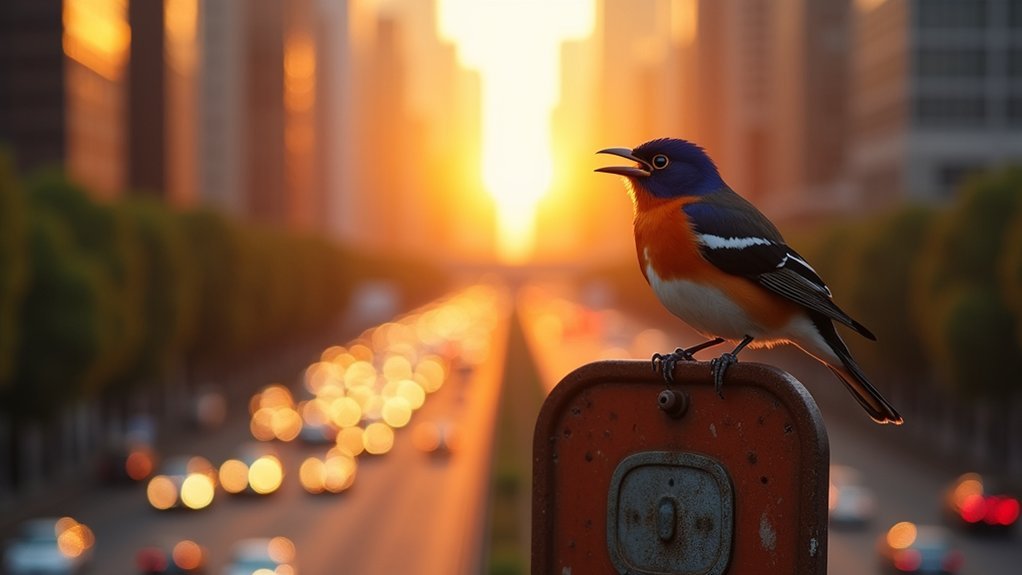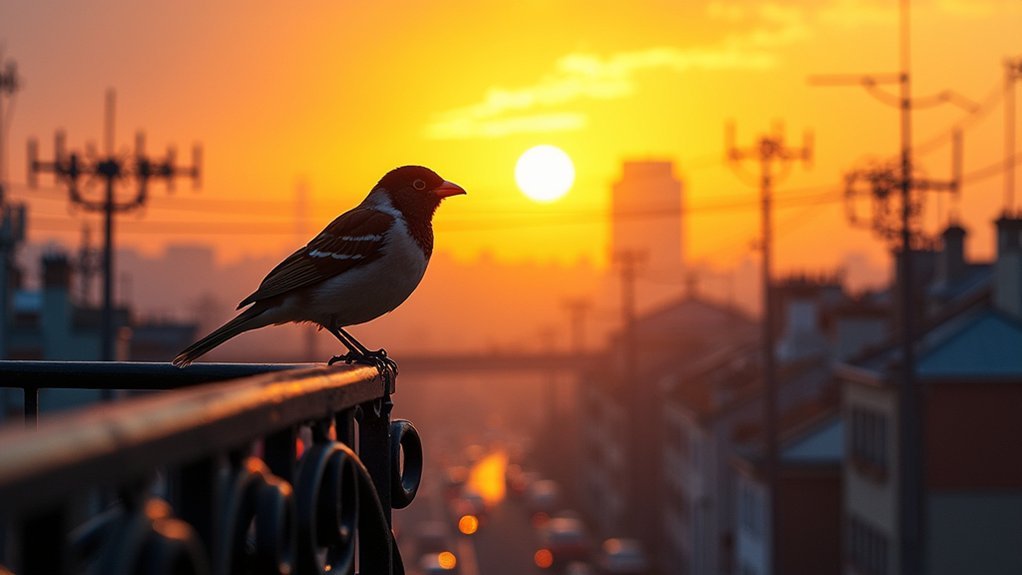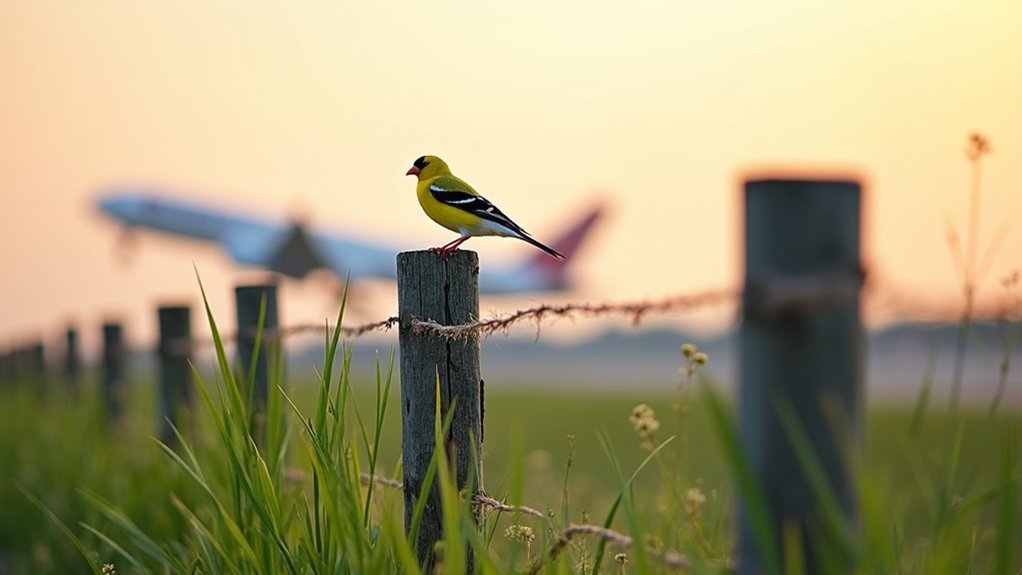Urban birds sing differently at dawn because they’re adapting to city challenges. You’ll notice they start up to 2 hours earlier than their rural counterparts, primarily due to traffic noise and artificial lighting. These environmental factors trick birds into believing dawn arrives sooner and push them to communicate before rush hour sounds drown them out. Their altered timing helps them avoid acoustic masking that would otherwise reduce their songs’ effectiveness. The surprising adaptations don’t stop there.
What Makes Urban Birds Sing Differently at Dawn?

While the quiet countryside sleeps, urban birds are already announcing the morning. You’ll notice these feathered city dwellers often begin their dawn chorus up to two hours before their rural relatives, adapting to the unique challenges of metropolitan life.
Two key factors drive this change: noise pollution and artificial lighting. Urban birds strategically shift their singing schedules earlier to avoid competing with rush hour traffic sounds.
In Seville, researchers documented birds advancing their performances by about 20 minutes in response to increasing traffic noise.
Artificial city lights further disrupt natural patterns, tricking birds into believing dawn has arrived well before actual sunrise. This urban adaptation creates a different acoustic landscape, as noise-sensitive species often abandon busy areas, leaving a less diverse but earlier dawn chorus.
The Unique Challenges of Urban Dawn Choruses
Although urban birds have adapted to sing earlier, they face multiple obstacles in making their voices heard effectively. In the early morning, you’ll notice these avian city dwellers competing with increasing noise pollution that threatens their acoustic communication success.
| Challenge | Impact on Birds |
|---|---|
| Traffic noise | Forces birds to sing up to 20 minutes earlier than rural counterparts |
| Artificial light | Disrupts natural dawn timing, triggering premature singing |
| Acoustic masking | Reduces effectiveness of songs for mate attraction and territory defense |
When you wake up to birdsong in the city, you’re hearing the results of remarkable adaptations. These birds must navigate a complex soundscape where their messages—critical for reproduction and survival—could be lost in the urban din if they don’t adjust their timing and delivery.
How Traffic Noise Reshapes Bird Communication Patterns

Traffic noise stands as perhaps the most disruptive force reshaping urban bird communication. When you’re still asleep, birds are already adapting their vocal strategies to be heard above the urban din.
Species like house sparrows and spotless starlings have shifted their singing routines approximately 20 minutes earlier to avoid competing with rush-hour traffic.
Urban birds have become dawn strategists, advancing their songs by 20 minutes to overcome traffic’s sonic invasion.
You’ll find sparrows typically begin their chorus 1-2 hours before dawn, while starlings start about 30 minutes pre-sunrise. This timing adjustment isn’t random—it’s a calculated response to guarantee their songs travel effectively.
As traffic noise intensifies in urban areas like Seville, birds increasingly rely on early morning quietude to communicate. Simple solutions like planting noise barriers could greatly improve these birds’ ability to communicate and thrive in our shared urban environments.
Light Pollution’s Impact on Morning Bird Songs
As cities glow through the night, light pollution severely disrupts the natural rhythms that govern bird behavior.
You’ll notice urban birds starting their dawn chorus up to an hour earlier than their rural relatives, confused by artificial lighting that mimics daylight.
This timing mismatch doesn’t just affect when you hear birds singing—it fundamentally alters their breeding and feeding patterns.
The constant exposure to light throws off their circadian rhythms, often leading to heightened stress levels that diminish song quality.
When you listen carefully to city birds, you’re hearing adaptation in real time.
They’re adjusting their vocalization strategies to cope with an artificially brightened environment, which can ultimately impact their communication effectiveness and mating success in our illuminated urban landscapes.
Timing Shifts: When City Birds Start Their Morning Chorus

The concrete jungle doesn’t just alter what birds sing—it dramatically shifts when they perform. You’ll notice urban birds starting their dawn chorus much earlier than their rural relatives, sometimes as early as 3 am when artificial light tricks them into believing morning has arrived.
| Factor | Impact on Urban Birds |
|---|---|
| Artificial Light | Triggers singing 1-2 hours before sunrise |
| Traffic Noise | Forces birds to sing ~20 minutes earlier |
| Rush Hour | Birds adapt by singing before noise peaks |
This early morning adaptation isn’t random—it’s strategic. City birds must navigate the acoustic challenges of their environment, starting their dawn chorus before the din of morning traffic drowns out their songs. House sparrows, for example, begin singing about 20 minutes earlier in response to pre-dawn noise, ensuring their mating calls aren’t lost in the urban soundtrack.
Pitch and Volume Adaptations in Metropolitan Areas
You’ll notice that city birds don’t just sing louder to overcome traffic noise—they’ve actually altered the pitch of their songs to be heard above the urban din.
House sparrows and starlings have shifted to higher frequencies, as these sounds travel more effectively through the cacophony of metropolitan areas.
This remarkable adaptation shows how birds can modify their vocal communication strategies in response to human-created noise pollution, ensuring their mating calls and territorial warnings still serve their essential purpose.
Noise Pollution Effects
Birds living in metropolitan areas face unique challenges that have driven fascinating vocal adaptations to survive in noise-polluted environments. You’ll notice urban birds adjusting their singing to overcome the constant hum of city life.
When noise pollution interferes with their communication, birds modify both their timing and vocal characteristics. House sparrows begin their dawn chorus about 20 minutes earlier to avoid rush-hour noise, while spotless starlings also shift their singing schedule when exposed to pre-dawn traffic.
| Adaptation | Urban Species | Benefit |
|---|---|---|
| Higher pitch | Various species | Avoids masking by low-frequency traffic sounds |
| Earlier dawn chorus | House sparrows | Reduces overlap with rush-hour noise |
| Increased volume | Metropolitan birds | Guarantees messages carry over ambient noise |
These adaptations highlight how environmental changes impact avian behavior, demonstrating birds’ remarkable resilience in our changing urban landscapes.
Song Frequency Shifts
Many urban birds have shifted their vocal frequencies to overcome the relentless cacophony of city life.
You’ll notice that species like house sparrows and starlings are singing earlier in urban environments, cleverly avoiding rush hour’s peak noise periods.
These feathered city dwellers have developed fascinating adaptations to guarantee their messages aren’t lost in the din.
They’ve increased both pitch and volume of their songs, allowing their communications to travel above the mainly low-frequency urban soundscape.
When you listen carefully, you’ll detect that urban birds produce clearer, more pronounced vocalizations than their rural counterparts.
These song frequency shifts aren’t random—they’re sophisticated adjustments that enhance their ability to attract mates and defend territories in challenging acoustic environments.
The metropolitan symphony of birdsong represents remarkable evolutionary flexibility.
Species Variations in Urban Vocal Adaptations

While surrounded by the constant hum of urban life, our feathered neighbors have developed fascinating vocal adaptations that vary considerably across species.
You’ll notice house sparrows and starlings singing up to 20 minutes earlier than their rural counterparts as they adjust to rising noise levels.
Male swamp sparrows take a different approach, improving their vocal performance throughout the day to overcome urban din.
If you’re an early riser, you might catch robins and blackbirds beginning their dawn chorus exceptionally early in artificially lit areas.
The species variations among urban birds extend beyond timing—some alter their song complexity and frequency to effectively cut through city noise.
These diverse vocal adaptations help guarantee their mating calls reach intended recipients despite the challenging acoustic environment they call home.
Comparing Rural and Urban Dawn Chorus Characteristics
Although the symphony of birdsong follows similar patterns worldwide, the dawn chorus in urban settings differs markedly from its rural counterpart.
You’ll notice urban birds often begin their morning songs 1-2 hours earlier than wild birds in rural areas, with house sparrows and spotless starlings starting approximately 20 minutes earlier in response to traffic noise.
When you listen closely, you’ll hear that urban dawn chorus lacks the diversity of rural soundscapes, as habitat fragmentation limits the variety of participating species.
Urban birds also compensate for background noise by singing louder and developing more complex vocalizations.
The characteristics of these urban performances vary considerably based on local geography, traffic patterns, and available green spaces—all factors that shape how city birds have adapted their morning melodies compared to their country cousins.
The Science Behind Earlier Singing in Noisy Environments

You’ll notice urban birds start singing notably earlier when faced with traffic noise, adjusting their dawn chorus timing by up to 20 minutes to avoid acoustic interference.
This behavioral adaptation helps them maintain effective communication for mate attraction and territorial defense, as their songs can travel farther during quieter pre-dawn hours.
Research confirms this remarkable sensitivity to sound fluctuations, demonstrating how noise pollution directly impacts critical avian communication patterns in city environments.
Noise Pollution Effects
As urban traffic roars to life each morning, birds face a critical communication challenge: how to make themselves heard above the din of city life.
You’ll notice urban birds adapting by singing up to 20 minutes earlier than their rural counterparts to avoid acoustic competition with traffic noise.
This early morning adjustment isn’t random—it’s a strategic response to noise pollution. House sparrows, typically vocal 1-2 hours before dawn, and spotless starlings, which naturally start about 30 minutes pre-dawn, both shift their singing schedules when surrounded by louder urban environments.
Research in Seville confirms this behavior is directly linked to traffic noise levels. When birds can’t effectively communicate, their survival may be compromised.
This highlights why urban planning should incorporate noise mitigation strategies to support wildlife communication in our increasingly noisy cities.
Shifted Song Timing
Why do birds in cities consistently rise earlier than their country cousins? Research shows urban birds like house sparrows and spotless starlings have shifted song timing by approximately 20 minutes earlier in response to urban noise patterns. This adaptation helps them communicate before the morning traffic crescendo begins.
The early morning shift appears strategic rather than random:
- Birds sing 1-2 hours before dawn to avoid competing with peak traffic noise
- Urban species adjust their vocalization timing based on sound environment sensitivity
- This shifted song timing represents a stress response to human-created noise pollution
- By singing earlier, birds maintain effective communication despite challenging acoustic conditions
You’re witnessing evolution in action when you hear pre-dawn urban birdsong—a remarkable behavioral adaptation to our noisy human world.
Seasonal Changes in Urban Bird Vocalization
While the concrete jungle buzzes with human activity throughout the year, the soundscape of urban birds follows distinct seasonal patterns.
You’ll notice a dramatic shift in vocalization during spring when male birds begin their earnest symphony to establish territories and attract mates. This breeding season transforms the urban dawn chorus into a rich, complex tapestry of sound.
The vocal landscape in cities grows more diverse as migratory species return in spring, adding new songs to the metropolitan soundtrack.
If you’re an early riser, you might be surprised to find these urban vocalists performing 1-2 hours before dawn, their timing influenced by artificial lighting that pervades city environments.
Throughout the year, birds continuously adjust their singing patterns in response to traffic noise levels, creating a dynamic, ever-changing urban soundscape.
Long-term Consequences of Altered Singing Behaviors
The urban adaptations in bird vocalization patterns carry significant long-term consequences beyond their immediate sonic adjustments. When you observe birds singing earlier in the morning in cities, you’re witnessing behavioral changes that disrupt their natural circadian rhythms and potentially their entire life cycles.
- Decreased reproductive success occurs as songs become masked by urban noise, making it harder for birds to attract suitable mates.
- Heightened stress levels result from increased singing activity, negatively impacting health and reducing longevity.
- Misaligned foraging and nesting behaviors emerge from shifted early morning vocalization patterns.
- Evolutionary adaptations to urban environments may permanently alter species distributions and community dynamics.
These consequences reshape not just how birds communicate but ultimately determine which species can thrive in our increasingly urbanized world.
How Building Materials Affect Sound Propagation for Birds
Urban architecture fundamentally transforms how bird vocalizations travel through city environments, creating an acoustic landscape vastly different from natural habitats.
When you walk downtown at dawn, you’re experiencing an acoustic environment shaped by concrete and glass—materials that reflect and amplify sound waves rather than absorbing them like natural surfaces.
These building materials create complex patterns of echoes and acoustic shadows, limiting how far bird songs can travel clearly.
You’ll notice that the dense arrangement of structures forms sound barriers, forcing our feathered neighbors to adapt their communication strategies.
Birds respond to these urban sound propagation challenges by singing earlier, before traffic noise intensifies, or by adjusting their vocal frequencies to cut through the urban din.
Their dawn chorus timing is a direct response to your city’s unique acoustic properties.
Frequently Asked Questions
Why Do Birds Sing Just Before Dawn?
You’ll hear birds sing before dawn because predators are less active, sounds travel further in cool air, and they’re not foraging yet. It’s their prime time for uninterrupted communication.
Why Do Birds Make so Much Noise at Dawn?
You’re hearing birds making noise at dawn because they’re establishing territories and finding mates when sound travels better. In cities, they’ll start earlier to avoid competing with traffic noise later.
Why Did the Bird Sing so Early in the Dawn?
The bird sang so early in the dawn because you’ll notice they’re avoiding competing with traffic noise. They’re adapting to your urban environment, taking advantage of better sound transmission, and communicating when it’s safer from predators.
Why Do Birds Start Chirping an Hour Before Sunrise?
Birds start chirping an hour before sunrise because you’ll notice they’re taking advantage of still, quiet conditions. They’re maximizing sound travel, avoiding predators, and communicating more effectively when temperatures are cooler and humidity is lower.
In Summary
You’ll find that urban dawn choruses represent remarkable avian adaptations to city living. As birds adjust their timing, pitch, and volume in response to human-made noise and light pollution, they’re fundamentally evolving new communication strategies. When you’re next awakened by early morning birdsong, remember you’re witnessing a complex behavioral response to urbanization—one that may have lasting implications for bird populations and biodiversity in your city.





Leave a Reply